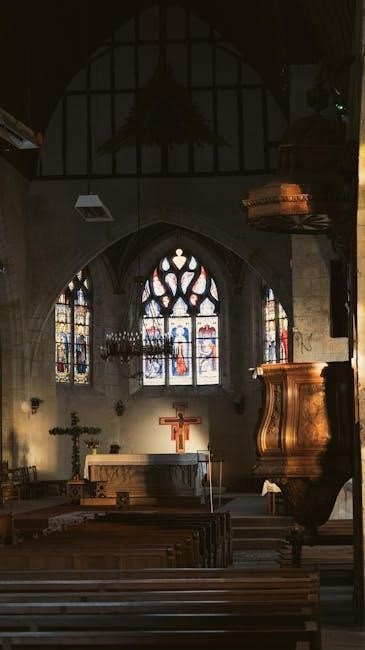The Way of the Cross PDF: An Overview
The Way of the Cross PDF resources offer a portable and accessible way to engage with this powerful devotion. These digital booklets compile prayers, meditations, and reflections, guiding individuals through Jesus’ final journey. They provide a structured framework for contemplating Christ’s sacrifice.

What is the Way of the Cross?
The Way of the Cross is a devotional practice commemorating Jesus Christ’s last day on Earth. It involves meditating on fourteen specific events, known as stations, from his condemnation to his burial. It is a journey of prayer;
Definition and Significance
The Way of the Cross, also known as the Stations of the Cross, is a Christian devotion that commemorates Jesus Christ’s final hours. It involves moving through fourteen symbolic points, or stations, each representing a specific event. These stations guide reflection on Jesus’ suffering.
The Way of the Cross holds deep significance for believers. It offers a structured way to contemplate Christ’s sacrifice and love. By walking in spirit with Jesus on his journey to Calvary, participants deepen their faith. They gain empathy and a renewed commitment to follow Christ’s teachings. This practice often fosters spiritual growth.

Key Elements of the Way of the Cross
The Way of the Cross is structured around specific stations, each with corresponding prayers and meditations. These elements combine to create a reflective journey through Jesus’ final hours. Each component serves to deepen understanding.
Stations, Prayers, and Meditations
The devotion centers on fourteen stations, each depicting a specific event from Jesus’ Passion. At each station, participants engage in prayers, often including the “Our Father,” “Hail Mary,” and “Glory Be.” Meditations on the meaning of each station, drawing from Scripture and tradition, provide deeper reflection. Booklets like those from the Knights of Columbus and others offer structured prayers and meditations. These prayers express gratitude, adoration, and hope, enhancing the devotional experience. The combination of stations, prayers, and meditations guides individuals to contemplate Christ’s sacrifice and apply its lessons.
Available PDF Resources
Numerous PDF resources offer various versions of the Way of the Cross. These include booklets with traditional prayers, modern reflections, and versions in multiple languages. These resources enhance accessibility for diverse audiences.
Booklets for Different Years and Languages
PDF booklets for the Way of the Cross are available in various editions, tailored for specific years, providing timely reflections. Many resources also offer translations in multiple languages, catering to a global audience. These booklets ensure that individuals can engage with this devotion in a way that resonates with their cultural and linguistic background. The availability of these resources promotes wider participation, enabling people from different communities to connect with the spiritual practice. Different versions are available, including traditional and contemporary adaptations, adding flexibility and depth.

Traditional vs. Modern Versions
The Way of the Cross devotion exists in both traditional and modern forms. These versions offer different approaches to prayer and reflection, catering to varied spiritual preferences. Each version aims to connect individuals with Christ’s passion.
Comparing Prayers by Saint Alphonsus Ligouri and Father Stefano Penna
The Way of the Cross offers diverse prayer styles, exemplified by Saint Alphonsus Ligouri’s traditional approach and Father Stefano Penna’s modern interpretation. Ligouri’s prayers emphasize sorrow and repentance, while Penna’s reflect contemporary concerns and language. Examining both reveals evolving spiritual needs. The Knights of Columbus provide booklets with both versions. Ligouri’s version offers classic expressions of faith, focusing on sin and redemption. Penna’s prayers offer relatable language, addressing modern challenges within the context of Christ’s suffering. Comparing these prayers shows the devotion’s adaptability.

Biblical Texts and Reflections
Incorporating scripture enriches the Way of the Cross, providing deeper meaning to each station. Biblical passages from the Gospels illuminate Jesus’s suffering. Reflections connect these passages to personal experiences, fostering a more profound spiritual connection.
Incorporating Scripture into the Devotion
Integrating biblical texts into the Way of the Cross devotion deepens understanding and reflection on Jesus’s suffering. The Gospels provide firsthand accounts of the events leading to the crucifixion, offering context and meaning to each station. By reading and meditating on specific passages, participants can connect with the historical and spiritual significance of Christ’s sacrifice.
Scriptural readings enhance the prayerful atmosphere, inviting individuals to contemplate the love, compassion, and obedience demonstrated by Jesus. This incorporation also strengthens the personal connection to the narrative, fostering a more profound and transformative spiritual experience.
Indulgences Associated with the Way of the Cross
The Way of the Cross has historically been associated with the granting of indulgences, signifying the remission of temporal punishment due to sins already forgiven. Engaging in this devotion, under certain conditions, allows the faithful to draw upon the treasury of merits earned by Christ and the saints.
These indulgences serve as a spiritual aid, encouraging deeper contrition and a renewed commitment to living a life of faith. The Church outlines specific requirements for obtaining indulgences, such as performing the devotion in a designated location, reciting prescribed prayers, and being free from attachment to sin.
The Scriptural Way of the Cross
The Scriptural Way of the Cross focuses on biblical accounts of Jesus’ Passion. It emphasizes direct passages from the Gospels, grounding the devotion in the historical and theological narrative of Christ’s suffering and death.
Focusing on Biblical Accounts
This approach to the Way of the Cross uses solely passages taken directly from Scripture. It aims to immerse participants in the actual words and events recorded in the Bible. By focusing on biblical accounts, the Scriptural Way of the Cross seeks to provide a clear and authentic experience of Jesus’ journey to Calvary.
This method helps to avoid interpretations or reflections that may not be directly supported by the text. It provides a raw and unfiltered encounter with the Passion narrative, which encourages a deeper understanding of the biblical text through prayerful contemplation.
The Fifteenth Station: The Resurrection
Adding a fifteenth station, the Resurrection, to the traditional fourteen stations shifts the focus towards hope. It acknowledges the suffering while emphasizing ultimate victory over death. It provides a powerful message of renewal and new life.
Adding a Focus on Hope
Incorporating the Fifteenth Station, representing the Resurrection, brings a crucial element of hope to the traditional Way of the Cross devotion. While the initial fourteen stations focus on suffering and sacrifice, adding the Resurrection emphasizes the ultimate triumph of Jesus Christ over death. This addition provides a powerful message of renewal and new life, reminding participants that the story doesn’t end with the crucifixion. It offers a sense of closure and reinforces the belief in eternal life, transforming the devotion from a somber remembrance to a celebration of victory and redemption. It allows for a more complete and uplifting spiritual experience.
Way of the Cross Coloring Pages
Way of the Cross coloring pages provide an engaging and creative way for both children and adults to reflect on the Stations of the Cross. These resources can enhance understanding through artistic expression.
Resources for Children and Adults
The availability of Way of the Cross coloring pages caters to a wide range of ages, offering accessible resources for both children and adults; For children, these coloring pages provide a visual and interactive way to learn about the Stations of the Cross, aiding comprehension and engagement with the spiritual themes. Adults can also find these resources beneficial for meditative reflection. The act of coloring allows for a focused and contemplative experience, deepening one’s connection to the Passion of Christ. Coloring pages can be adapted for various skill levels, making them suitable for individual or group activities. They serve as valuable tools for religious education and personal devotion.
Closing Prayer
The closing prayer of the Way of the Cross expresses gratitude for Christ’s sacrifice. It offers adoration and seeks hope in God’s mercy, revealed through the Cross. This prayer concludes the devotional practice with reverence.
Gratitude, Adoration, and Hope
The closing prayer encapsulates feelings of profound gratitude for Jesus Christ’s ultimate sacrifice. It acknowledges the immense love demonstrated through His suffering and death on the Cross. We express heartfelt thanks for the redemption offered to humanity.
Furthermore, the prayer embodies adoration, revering Christ as Lord and Savior. It recognizes His divine nature and the holiness of His act of selflessness. We humbly bow before His sacred sacrifice, acknowledging His supreme authority.
Finally, the closing prayer is infused with hope, looking forward to the promise of eternal life. It acknowledges the Resurrection and the triumph over death, trusting in God’s unwavering mercy. We seek solace and strength in His divine presence.




